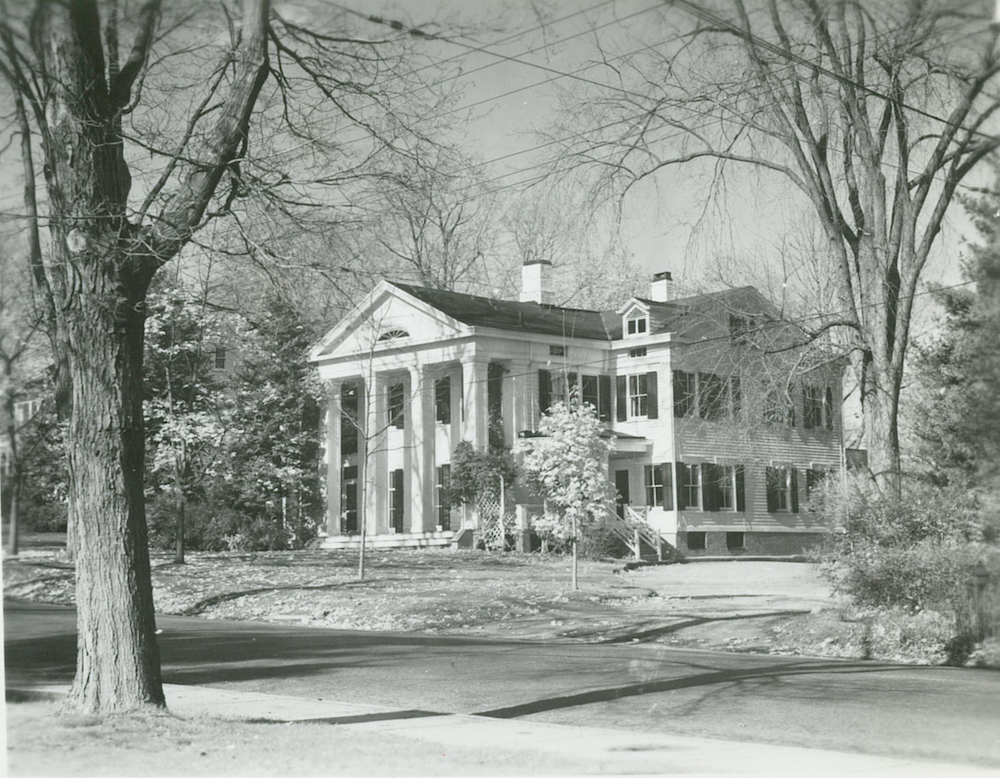46 Main St.
“New Canaan Now & Then” is presented in partnership with the New Canaan Museum & Historical Society.
The Comstock-Bensen House has had surprisingly few owners in its long history, having been built in 1841 (Historical Buildings of CT lists the date as 1842 and the New Canaan Property Records list it as 1850).
The Greek Revival home on the corner of Main Street and Heritage Hill Road was built by Edson Bradley on land he purchased from Seymour Comstock. Bradley, whose original purchase was only for one half acre, supplemented his property over the thirteen years he owned it by buying small adjoining parcels from Comstock, Samuel Silliman and Samuel Stevens. Edson Bradley was a partner in the shoe making business of Bradley and Benedict. His partner was Caleb S. Benedict. According to the New Canaan Advertiser article dated February 9, 1933 the firm had many customers in the Southern states and when the “war of the rebellion” occurred in 1861 they lost thousands of dollars. Bradley took this opportunity to retire and the business was reorganized to include Caleb Benedicts relatives, becoming J and J Benedict. Edson Bradley then sold his property to Seymour Comstock’s brother, Albert.
Albert Comstock was a partner in the clothing company of Comstock and Rogers. During the Comstock era, the house at 46 Main Street (or 93 N. Main Street before the renumbering of houses) was known as Colonial House. It was even listed under this name under the street directory at the time. Albert Comstock was a prominent citizen of the town, and he and his wife were involved in community activities. Mr. Comstock was committed to the formation of the public library and left $3000 in his will to the Library Committee. The Comstocks were also instrumental in the formation of the New Canaan Historical Society; Mrs. Comstock served as the first president and Mr. Comstock was a charter member. The first meeting of the Historical Society took place in their home in 1889. The Comstocks lived in Colonial House until Albert Comstock’s death in 1909.
In 1910 the property was purchased by Charles W. Gordon. Mr. Gordon sold it to Elizabeth Ferguson in the same year. Ms. Ferguson sold it a year later to the New Canaan Realty and Construction Group. In 1912 Joseph Howe bought the property and resold it to the New Canaan Realty and Construction Group in 1920. During these years, 46 Main Street was a day school for children, a boarding house and doctors offices on the lower level. In 1920, Mrs. Helen Peabody Goodell bought the property and not only restored it but added two side porches and a sleeping porch in the rear. Mrs. Goodell married Willard Robinson Downing of St. John Place a year later.
In 1926 the Bensen family purchased the home. Mr. Albert VanVoast Jr. and his wife had three children: Albert “Ben”, Robert and Harriet. All three of the Bensen children were war heroes, including Harriet who was awarded 4 Bronze stars for her service in the Red Cross. Harriet was also briefly a librarian at the New Canaan Country School. Her brother, Ben, was a fixture at the New Canaan Country School. He worked as a teacher and a coach for 29 years before his retirement in 1979. The Bensen family sold the property to Irving Beck on October 22, 1964. In 1997 the current owners, Main Street Group, purchased the property.




Wonderful series on historic New Canaan!….So many names in this piece were associated (even buried) in the Maple Street Cemetery dominated by the leaders in the shoemaking trade so important to early New Canaan. In fact, it was a Bendict who founded this cemetery- now known as Maple Street Cemetery- which needs restoration as it is being lost to surrounding condo development. What is left should be fenced, respected, by the town and made into a special place to visit. The entrance is thru the The Vue development, off Cherry Street. There is signage identifying the burial ground and a list of those buried there. The public is welcome to visit and there is lots more information at the N.C. Museum & Historical Society if you are interested.
I remember this house with a mixture of emotions. my father, Irving Beck, wanted me as a 16-year old with no skills at all, to help with remodeling and renovating the interior. He was a harsh taskmaster; it was not fun, and as his oldest child in 1964, he expected me to work unpaid.
He was proud of the finished building. he had used Black workers whenever possible, which as likely shocking to the local residents of the time.